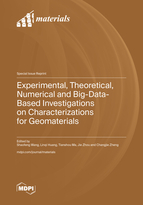Experimental, Theoretical, Numerical and Big-Data-Based Investigations on Characterizations for Geomaterials
A special issue of Materials (ISSN 1996-1944). This special issue belongs to the section "Construction and Building Materials".
Deadline for manuscript submissions: closed (20 May 2023) | Viewed by 24433
Special Issue Editors
Interests: rock mechanics; geomechanics; geomaterials
Special Issues, Collections and Topics in MDPI journals
Interests: geomechanics; microseismic monitoring
Special Issues, Collections and Topics in MDPI journals
Interests: petroleum engineering; petroleum related rock mechanics; geomechanics; measurement while drilling; unconventional oil & gas; geothermal energy; advanced drilling technologies and tools
Special Issues, Collections and Topics in MDPI journals
Interests: soil mechanics; tunneling engineering
Special Issue Information
Dear Colleagues,
Rock and rock-like materials such as concrete, soil, and underground backfilling materials are considered to be geomaterials. Geomaterials are essential for life due to human construct extraction, mining, storage, and transport areas in the Earth’s crust for raw material. Drilling and excavations of underground openings in the Earth’s crust are requirements for the exploitation and utilization of mineral resources, energy resources, and underground spaces. The deepest drilling depth has exceeded 12 km, and the deepest underground excavation now operates mines with depths exceeding 4 km to 5 km. Drilling, excavation, and rock support processes largely rely on the physical and mechanical properties of geomaterials. Rock excavations are faced with some instability phenomena, such as caving, rockbursts, slabbing, large deformation, and zonal disintegration, posing a serious threat to the safety of mining and tunneling operations. Rock drilling also encounters many challenges in deep underground. Deformation, fracture, failure, and fragmentation are the different stages of geomaterials, the monitoring and control of which are essential for ensuring drilling and excavation safety. Therefore, understanding the response processes of geomaterials during drilling and excavation activities depends on the precise characterizations for geomaterials. However, it remains a significant challenge to fully understand the deformation/fracture/failure/fragmentation behaviors and mechanisms of geomaterials in complex underground environments.
This Special Issue aims to call for research papers and review articles encompassing in situ observations, laboratory experiments, theoretical analyses, numerical simulations, and big-data-based analyses concerning characterizations for geomaterials.
Potential topics include but are not limited to the following:
- Geomaterials;
- Rock and rock-like materials;
- Geomaterial dynamic response;
- Geomaterial behaviors;
- Geomaterial strength;
- Geomaterial deformation, geomaterial fracture.
Dr. Shaofeng Wang
Dr. Linqi Huang
Prof. Dr. Tianshou Ma
Dr. Jie Zhou
Dr. Changjie Zheng
Guest Editors
Manuscript Submission Information
Manuscripts should be submitted online at www.mdpi.com by registering and logging in to this website. Once you are registered, click here to go to the submission form. Manuscripts can be submitted until the deadline. All submissions that pass pre-check are peer-reviewed. Accepted papers will be published continuously in the journal (as soon as accepted) and will be listed together on the special issue website. Research articles, review articles as well as short communications are invited. For planned papers, a title and short abstract (about 100 words) can be sent to the Editorial Office for announcement on this website.
Submitted manuscripts should not have been published previously, nor be under consideration for publication elsewhere (except conference proceedings papers). All manuscripts are thoroughly refereed through a single-blind peer-review process. A guide for authors and other relevant information for submission of manuscripts is available on the Instructions for Authors page. Materials is an international peer-reviewed open access semimonthly journal published by MDPI.
Please visit the Instructions for Authors page before submitting a manuscript. The Article Processing Charge (APC) for publication in this open access journal is 2600 CHF (Swiss Francs). Submitted papers should be well formatted and use good English. Authors may use MDPI's English editing service prior to publication or during author revisions.
Keywords
- geomaterials
- rock and rock-like materials
- geomaterial dynamic response
- geomaterial behaviours
- geomaterial strength
- geomaterial deformation
- geomaterial fracture











